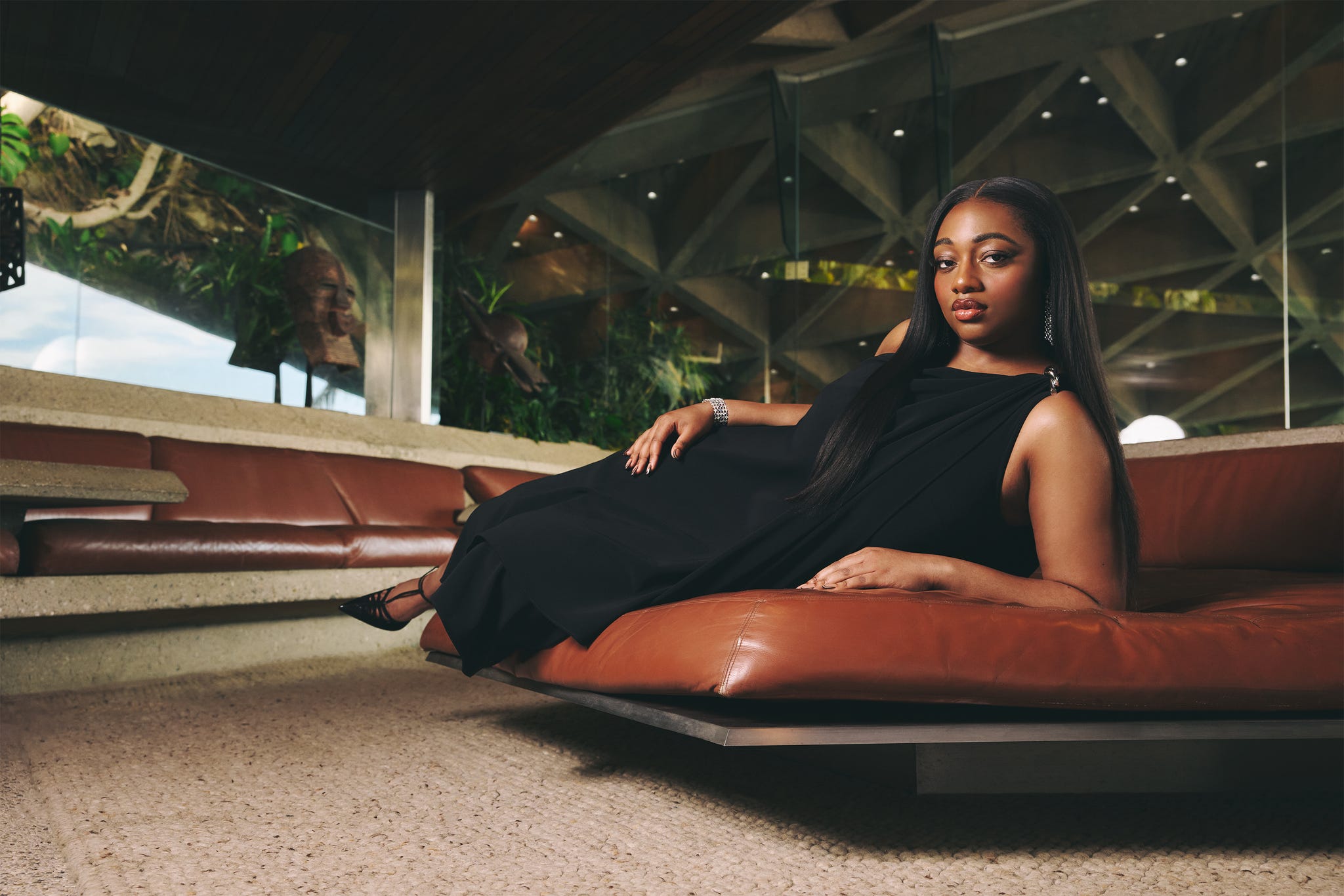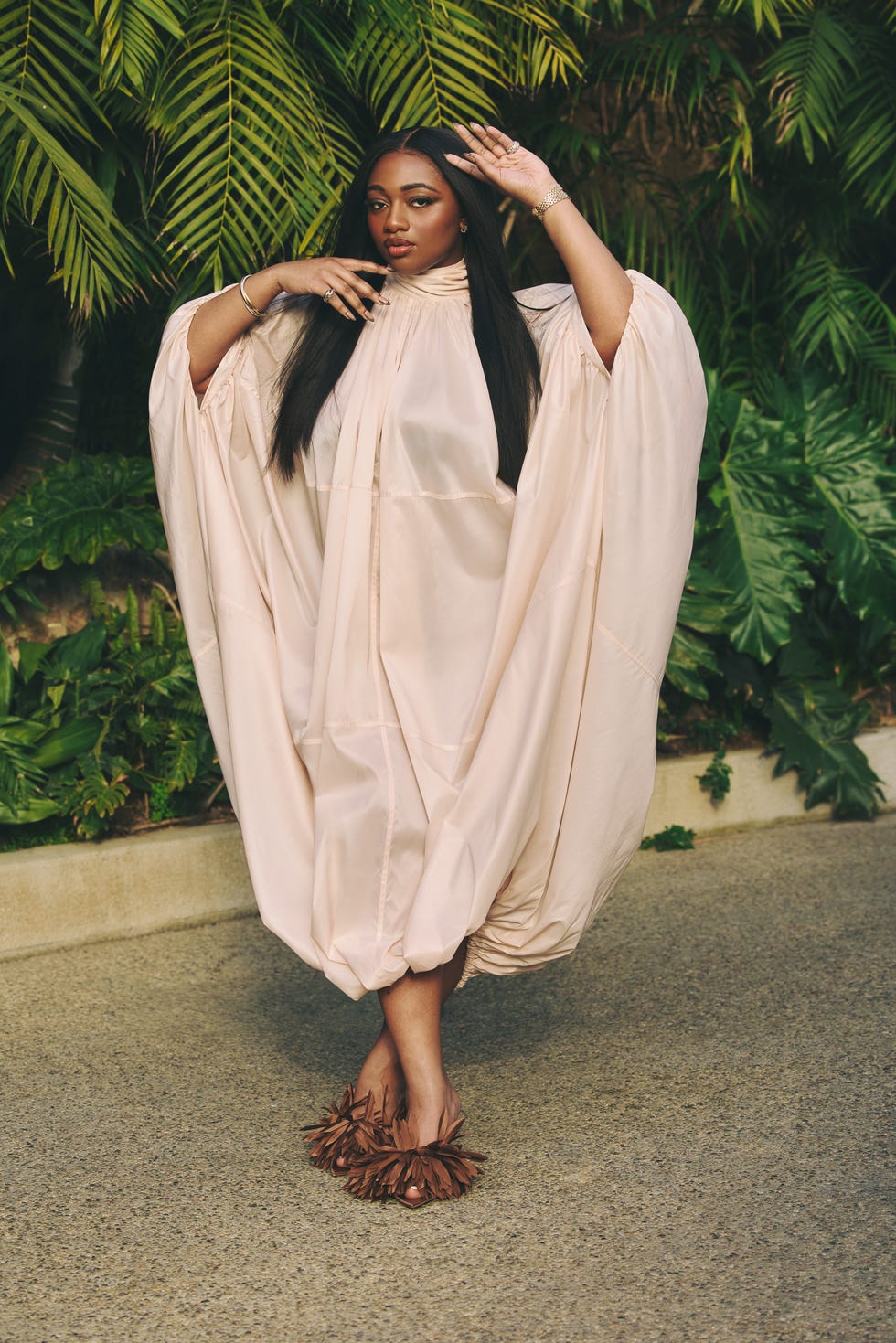Samara Joy Is Bringing Jazz to a New Generation


Dress, Halston. Earrings, bracelet, Van Cleef & Arpels. Heels, Aquazzura.
Music runs in Samara Joy’s blood. Her grandparents founded a gospel group in Philadelphia called The Savettes, and her father, Antonio, is a bassist and singer. But while it always made sense for her to become a professional musician, winning five Grammys within four years of graduating from college—including Best New Artist—is a level of extraordinary success that few could predict.
For many young fans, the 25-year-old Bronx native’s voice has been their introduction to the genre. Joy joined TikTok around the same time as she was recording her 2021 eponymously debut album. She’d been somewhat resistant to social media, but that quickly changed when she saw the reach it gave her. “I was scared that my content would look the same as everybody else’s—I thought, ‘I’m just singing to camera, everybody does this,’” she says. “But once a bunch of strangers started gravitating toward it, I was like, ‘Oh, my gosh, this is crazy.’ And I still feel this invisible but tangible embrace from the community.”
She quickly became a star of JazzTok, a community of jazz fans of different ages that has helped grow the genre among a younger audience. “My little pocket of the internet has found people who have never listened to jazz,” she says. “I’m not sure how it happened, but I’m grateful it did.” Her high-profile fans include LaKeith Stanfield, Chaka Khan, and Anita Baker.
“I never wanted to feel like, ‘Oh, now that I’ve reached this height so fast, there’s nowhere else to go from here.’ Because, in fact, there is.”
Last October, Samara Joy released Portrait, her third album. Recorded over just three days, it gave her a new sense of power and creativity. “This album was different from my last two, because there was a period of time when I felt like I had to make a lot of decisions for myself and I had to grow up and stand up for myself and my ideas,” she says.
She is on tour with Portrait through the summer, and late last year performed 13 shows with her family to promote a holiday album. She was joined by her 94-year-old grandfather, Elder Goldwire McLendon (who came out of retirement to join), as well as her father and her uncle and cousins, who are all vocalists. “Audiences come out to see my family perform together. It’s a beautiful thing because they get to share that memory with their own families,” Joy says. “My grandfather is getting the chance to see this legacy play out—to see all of us still enjoying music from when he and my grandmother first introduced it to us in church to now us being able to do it all together once again after a lot of detours.”
She’s grateful to legends like Ella Fitzgerald and Sarah Vaughan for paving the way and hopes to do the same in her own career. “I never wanted to feel like, ‘Oh, now that I’ve reached this height so fast, there’s nowhere else to go from here.’ Because, in fact, there is.”

Dress, Ferragamo. Earrings, watch, rings, Cartier. Shoes, Gianvito Rossi.
It was constantly inspiring. My ears were trained early to listen to music in a different way. I enjoy thinking about why I loved my dad’s voice so much, and the riffs and runs he did and how he did them and where he placed them in the song. When he played bass, how melodic everything was. I feel like I learned from a place of singing with feeling and playing with feeling.
When did you decide that you were going to focus on jazz?I was introduced to jazz in high school, but I wasn’t really interested in doing it or listening to it. I just didn’t connect with it at that time. But I learned one or two jazz songs, and when it came time to choose a college, I was auditioning for different programs with those songs. I was hoping that even though I had very limited knowledge of this music, maybe they could see the potential with this one song. When I got accepted to [the State University of New York at] Purchase’s Conservatory of Music, I was like, “This is serious. I need to focus, really immerse myself in the music.”
How did studying in a conservatory change your relationship to music?It broadened my perspective on collaboration, because we had all of these students with the same goal in one place. Up until that point, my relationship with music obviously stemmed from my family. It was nice to reframe my role and be able to listen and take in the music that was happening around me and [think about] how I could contribute to it and interact with it.
The first memory was fed to me by my dad, who has a cassette of me when I was three years old singing an Usher song. I think the song was “U Don’t Have to Call.” It’s one [memory] that I hold dear now—it’s like, “Whoa, I was three years old singing!” And my earliest memory was singing in church at 10 years old. My first solo was “Oh Happy Day.” I remember being nervous, but I had on my Easter dress.
Regina King revealed herself as a fan in a Hollywood Reporter video, and later sought you out to record an original song when she was making the movie Shirley. What was that like?That was my first time being acknowledged by a celebrity in that way. I was like, “She knows who I am. Oh my God.” At that time, I had no social media presence. I had zero. It was none. I was not posting singing videos or anything. So that’s why I was like, “How did she find me?”
During the pandemic, I sang this song with a professor of mine to thank the Ella Fitzgerald Charitable Foundation for giving me a scholarship. That video went viral, but it was on Facebook. I’m guessing that had to be the only video that she saw, or maybe she listened to an album—I don’t know. But to this day, it’s so strange because I was just like, “How is this even possible that she’s talking about me to a room full of people like Spike Lee?”
Hair by Lacy Redway for Tresemmé; makeup by Alexandra French at Forward Artists; manicures by Natalie Minerva at Forward Artists and Ginger Lopez at Opus Beauty; produced by Petty Cash Production.
A version of this story appears in the May 2025 issue of ELLE.
elle





